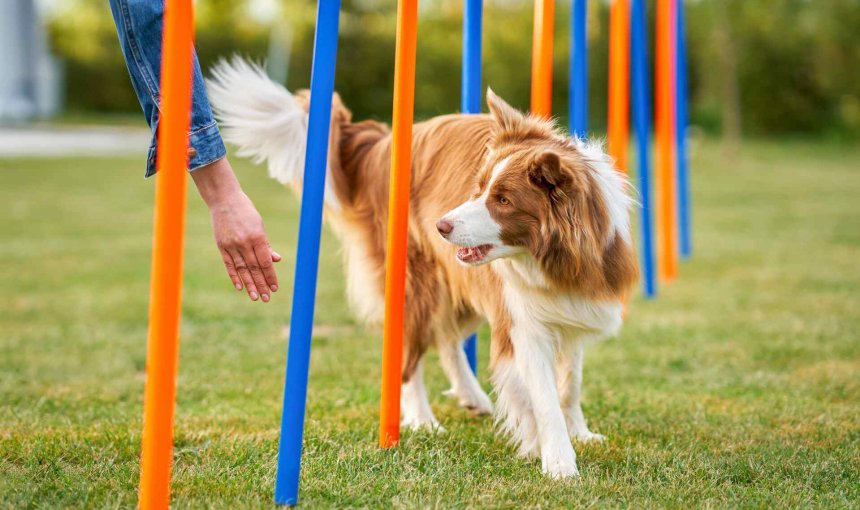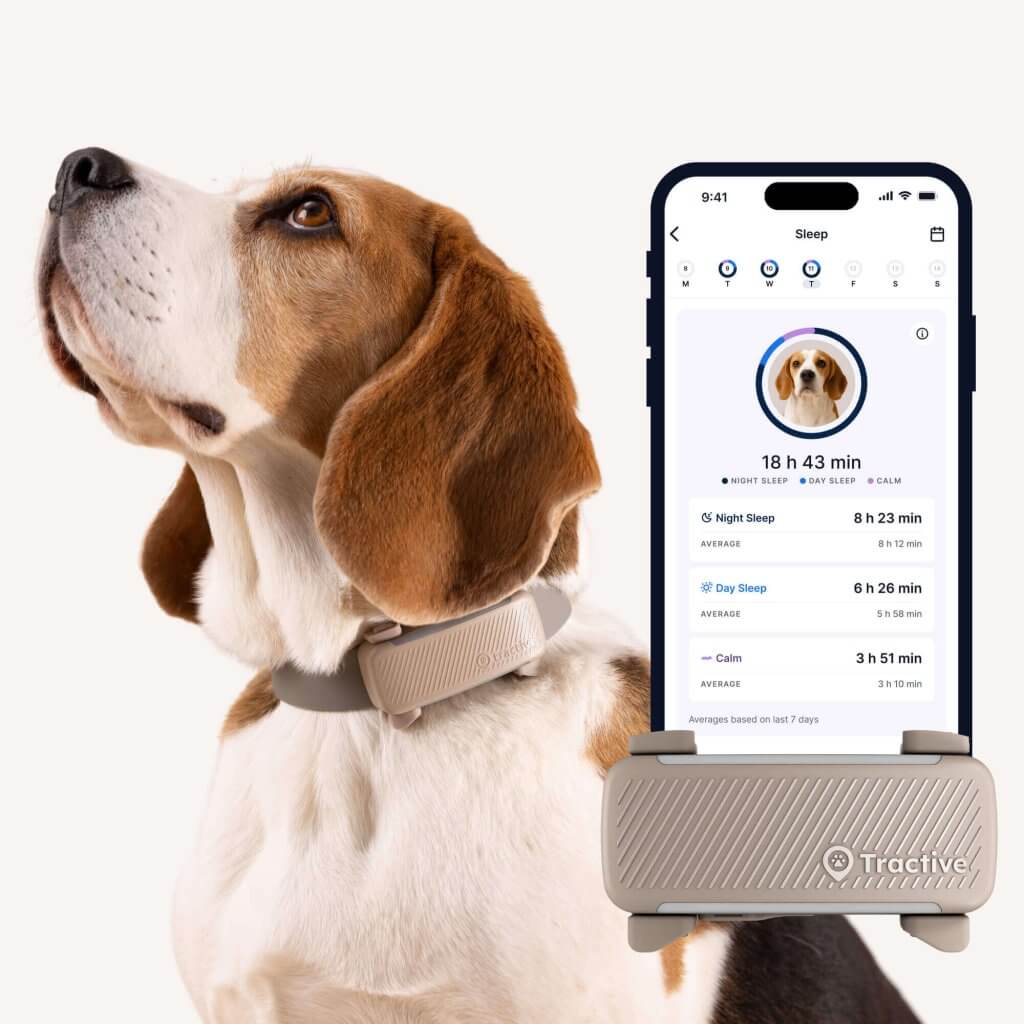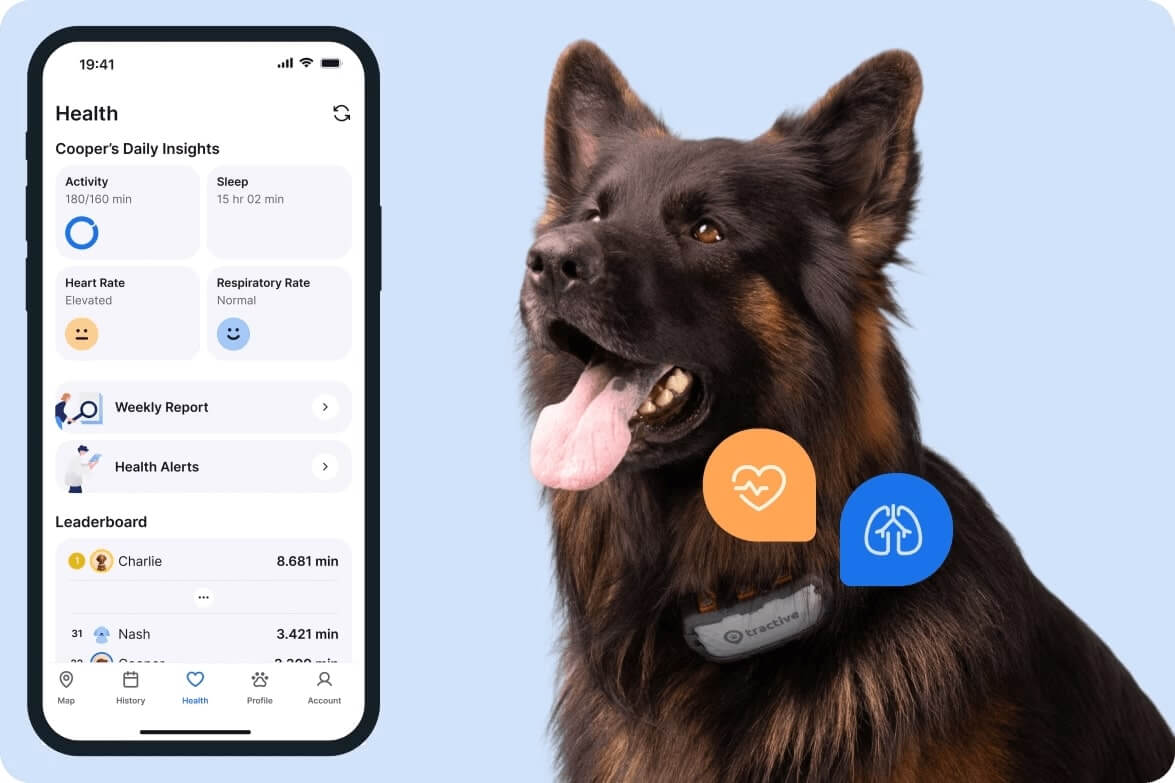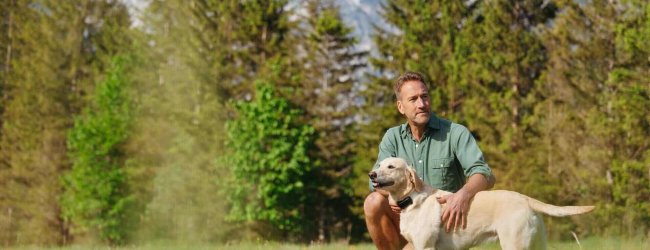Dog Agility Training: How To Get Started (And Good)
Whip out those broomsticks and old tires - and let's get started!

Daily physical activity can keep your pup in tip-top shape – but at some point you might find them getting a bit bored of just fetch or a frisbee. So if you and your dog make a great sporty team together, check out dog agility training. Here’s how to get started and how to keep track of your buddy’s activity goals.
Key Takeaways
Agility isn’t just about physical exercise – it also stimulates your dog’s brain, enhances coordination, and builds confidence through learning and teamwork.
Common agility elements include jumps, tunnels, weave poles, and pause tables. You can use some household items to begin at home – like broomsticks for jumps or toys for obstacles.
The Tractive GPS & Health Tracker lets you monitor your dog’s activity levels and vital signs, so you can keep track of your dog’s active minutes, calories burned, and even breathing and heart rate.

Always know your buddy is healthy & safe
Read moreWhat’s “agility” in the first place?
By definition, “agility” is the ability to move quickly and efficiently while changing position frequently. Agility is also the name of a fast-paced, challenging dog sport. Agility trials take place on a course that includes about 15 obstacles that require:
- Twisting through upright weave poles,
- Climbing up elevated walkways,
- Stopping atop a pause table,
- Leaping through tire jumps, and zipping through tunnels.
Dogs and their handlers work together as a team to navigate the obstacles in the correct order.

You and your dog can sign up for competitive agility trials. Or you can participate in agility just for fun, without the pressure of competition. You can even create a backyard agility course using broomsticks and your kids’ old toys.
Either way, agility is a great way for your pup thrive by getting physical and mental exercise. As a bonus, you’ll get a workout, too!
What are the benefits of agility training?
Agility training offers many benefits for your pup, including heart-pumping activity and problem solving. Don’t worry – your pup does not need to be a national agility champion to enjoy its perks. It’s a great way to get some:
- Physical and mental exercise
A few minutes of agility training each day can add an extra dose of physical activity and mental stimulation that will engage your dog’s brain and tire them out. - Extra obedience training
In a more fun, free environment. Agility requires your dog to pay close attention to your commands. Just staying focused is a challenging mental workout for your pup. It also allows them to put their instinctive abilities to work. - Healthy weight management
To be agile, your dog needs to have good body condition and be physically fit. Working dog breeds take well to agility, because they are naturally high-energy. But any dog can participate in agility, albeit at a slower pace. If your dog is overweight or out of shape, agility training could help your dog get fit. - Mobility training
Agility requires your dog to have good core strength to control their mobility from side to side. It may take some practice to help your dog get ready for agility. But the health benefits to your dog are worth it.
💡A dog GPS tracker that includes Health Monitoring can also track your dog’s activity – including calories burned, their vital signs (like breathing and heart rate), and even how active your dog is compared to other, similar dogs around the world.

Help your dog stay fit and healthy
Get a complete overview of how much exercise and rest they’re getting. Compare their activity to that of similar dogs. Set daily goals. And find out if something might be off with Health Alerts.
What should you consider before starting an agility program?
Agility training can be as simple as teaching your dog to jump onto a low bench in your back yard. Or as complex as entering a high-level agility competition. Have your vet perform a physical exam on your dog before undertaking any new type of dog training or exercise program. Then consider:
Is my dog suitable for agility?
- Health
Your pup should be in generally good health to undertake agility training. If your dog has an injury or is elderly, this may not be the right time to introduce dog agility training. - Fitness level
If your dog is not accustomed to lots of exercise, ask your vet or a trainer about safe ways to introduce more activity into your pup’s routine before getting started on agility. - Breed characteristics
Some dogs, especially those with short legs and long torsos, may have difficulty with agility training. But you can still work on basic obedience to provide the daily mental stimulation they require. - Temperament & training
Your pup should be comfortable around other dogs, especially if you plan to attend agility events. Figure out what motivates your dog. It’ll help you get them through the challenging (and sometimes tiresome) dog training sessions and competitions. They may be happy to work for treats or simply a “good dog” from you.
Is agility suitable for me?
Agility is a team sport, and you are part of the team. You will need to have a basic fitness level to keep up, and the mental stamina to encourage your pup through the tough times. This might be the time to start a fitness routine to increase your own agility and balance so you can be a solid teammate for your pup!
Dog agility training takes time, but it will be worth it when you and your dog become a dynamic duo on the agility course.
When to start with dog agility training
Puppies and young dogs may get injured doing hurdles or big jumps, so most dogs enter agility competitions around age 1 or 2. You can get a head start by teaching your puppy basic obedience before they are old enough to compete. Work on mastering basic obedience commands like Sit, Lie Down, Heel, Stay, and Come.
Just keep in mind: puppies have very short attention spans. Keep training sessions brief and always end on a positive note, with a successful behavior followed by a treat or belly rub.
Instead of training your puppy on your own, consider signing up for basic obedience training classes. At class, your puppy will learn to socialize properly with other dogs and humans, and you’ll learn dog training concepts that you can use throughout your dog’s lifetime.
How to start dog agility training at home
Before you get started, remember that agility requires movements that may seem unnatural to your dog. Like, for example, walking backwards, making tight turns, or crawling in narrow spaces. Practice these moves before taking your pup onto the obstacle course.
Next, start in your back yard with simple homemade obstacles like benches and small tables for your dog to jump onto or crawl under.
- Practice turning back and forth around the flagpole.
- Lay a broomstick over two bricks to create a mini-jump.
- Gradually increase the difficulty level of these activities as your pup gains confidence. Try to complete 2 or 3 short workouts, followed by lots of praise, some treats, and a “good dog” ear rub, then take a break.
To have a successful agility session, your dog should be able to keep their attention on you, even amid distractions. Practice commands like Look or Watch Me (followed by a treat if successfully achieved) so your dog learns to focus only on you. Agility is normally performed off-leash, so be absolutely certain that you can recall your pup at a moment’s notice, even in a crowd of dogs and people.
Introduce contact obstacles
Once your pup has mastered a few agility basics and can be trusted to follow simple commands, introduce some of the specific obstacles used in agility courses. Contact obstacles are items that your dog is required to touch with at least one paw during the competition. Practice by setting treats at the contact point and only give your dog the treats if they put their paw there.
Contact obstacles used in competitions include a steep a-frame walkway that dogs must walk up and down, and a balance beam that dogs must walk along. Get creative with items from your garage to practice navigating these obstacles in your back yard.
Try tunnels
Begin teaching your dog to navigate tunnels using an old tire or a large cardboard box with the ends open. Toss a few treats inside the tunnel, or have a friend stand at the opposite end with a treat. Give the Tunnel command as they pass through. Once your dog in comfortable with short tunnels, gradually increase the length of the tunnel. Eventually, you can make it more challenging by adding some curves so your dog can’t see the end of the tunnel.
Teach jumps
For your pup’s first jumps, start with a bar just an inch or two off the ground to create a low hurdle. With your dog on a lead, walk quickly toward the hurdle together and give the Jump command. If successful, give a treat and lots of praise.
If your pup tries to skirt around the hurdle, place the hurdle in a narrow hallway instead of an open area. Stand on the opposite side of the hurdle from your pup. Be encouraging, and your dog will probably jump over the pole (or at least step over it). Keep practicing for a few minutes every day. Raise the bar a little every week. Your dog will soon be a confident jumper.
Build confidence with moving objects
Moving objects like the teeter board are especially challenging for dogs when they first start agility training. The teeter board is exactly like playground seesaw: your dog must walk from one end to the other and navigate the tipping of the board. You can help your dog prep for this activity by setting a piece of plywood on top of a tennis ball to make it unstable. Reward your dog for simply being interested in the board or placing a paw on top. Eventually, they’ll stand on it and balance like a pro.
If you aren’t having success training your pup for agility trials at home, consider taking agility classes. You may learn some techniques that help your dog achieve feats that you never thought possible!
Where a smart dog tracker can help
When you’re diving into dog agility training, keeping track of your pup’s activity and health can make a big difference. With a smart dog tracker like Tractive, you can see how many active minutes your dog racks up, how many calories they’re burning, and the total distance they cover while zooming through the course.
Better yet, you can also monitor your dog’s vital signs – including their breathing and heart rate. So you can adjust your exercise level accordingly and ensure your buddy’s getting just the level of intensity they need. It’s like having a little fitness coach right on your dog’s collar.

Finally, the leaderboard feature adds a bit of friendly competition. You can see how your dog stacks up against others and maybe even challenge your friends to get those tails wagging a little more. It’s a fun way to stay motivated and make sure your pup is staying healthy and happy while training hard.
And if you’ve found this post helpful, share it with a friend or a loved one – and let’s help build a safer, kinder world for our furry friends together.



